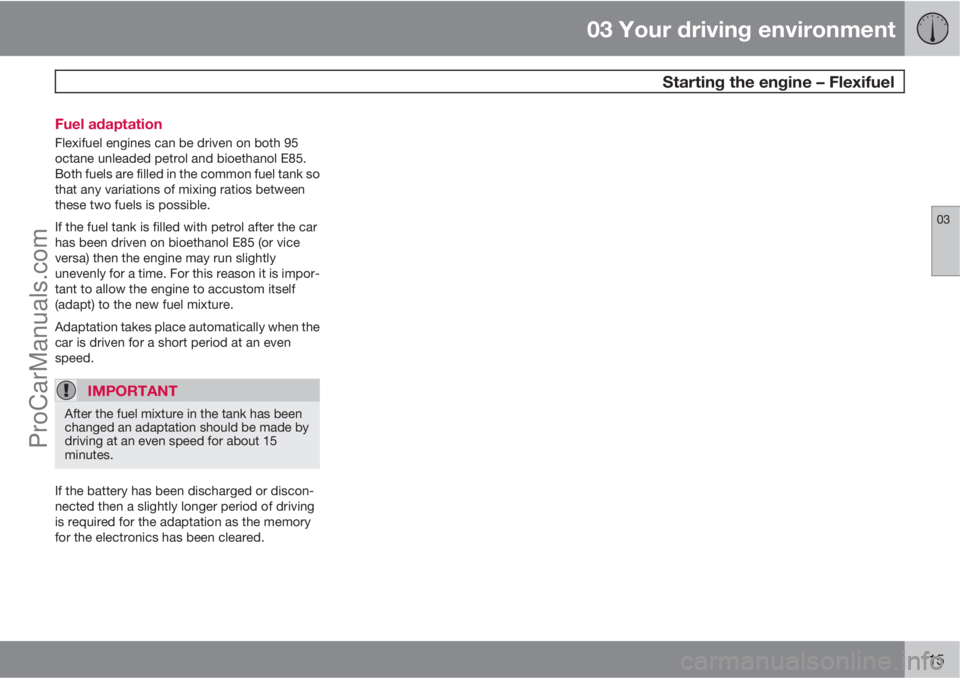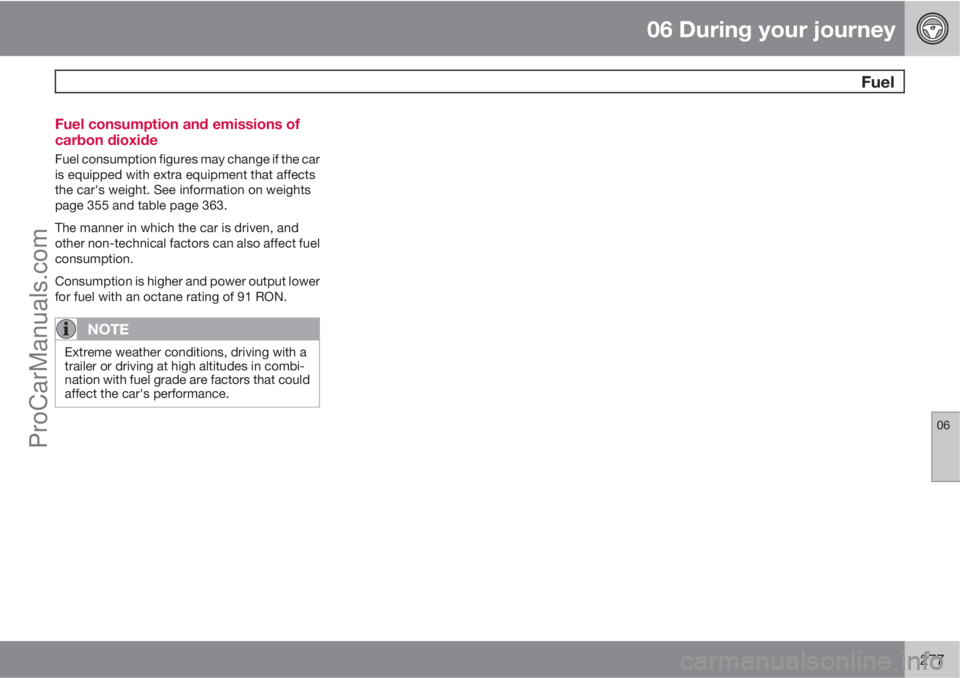2012 VOLVO V60 octane
[x] Cancel search: octanePage 116 of 400

03 Your driving environment
Starting the engine – Flexifuel
03
114* Option/accessory, for more information, see Introduction.
General information about starting
with Flexifuel
The engine is started in the same way as in a
petrol-engined car.
In the event of starting difficulties
If the engine does not start at the first start
attempt:
•Make further attempts to start with the
START/STOP ENGINE button.
If the engine still does not startThe outside temperature is lower than +5 °C:
1. Connect the engine block heater for at
least 1 hour.
2. Make further attempts to start with the
START/STOP ENGINE button.
IMPORTANT
If the engine does not start despite repeated
start attempts, you are recommended to
contact an authorised Volvo workshop.
Engine block heater*
Electrical input to the engine block heater.
When the temperature is expected to be lower
than –10 °C and the car has been refuelled with
bioethanol E85, an engine block heater should
be used for about 2 hours to facilitate the quick
starting of the engine.
The lower the temperature, the longer the time
required with the engine block heater. At
-20 °C the heater should be used for approx. 3
hours.
Cars intended for E85 have an electric engine
block heater*. Starting and driving with a pre-
heated engine involves significantly lower
emissions and reduced fuel consumption. For
this reason you should aim to use the engine
block heater throughout the winter months.
WARNING
The engine block heater is powered by high
voltage. Fault tracing and repair of an elec-
tric engine block heater and its electrical
connections must only be carried out by a
workshop - an authorised Volvo workshop
is recommended.
NOTE
Points to remember for carrying reserve
fuel:
•In the event of stalling due to an empty
fuel tank, bioethanol E85 from a reserve
fuel can may make the engine difficult
to start in extreme cold. This is avoided
by filling the reserve fuel can with 95
octane petrol.
For more information on Flexifuel's bioethanol
E 85 fuel, see page 275 and 363.
ProCarManuals.com
Page 117 of 400

03 Your driving environment
Starting the engine – Flexifuel
03
115 Fuel adaptation
Flexifuel engines can be driven on both 95
octane unleaded petrol and bioethanol E85.
Both fuels are filled in the common fuel tank so
that any variations of mixing ratios between
these two fuels is possible.
If the fuel tank is filled with petrol after the car
has been driven on bioethanol E85 (or vice
versa) then the engine may run slightly
unevenly for a time. For this reason it is impor-
tant to allow the engine to accustom itself
(adapt) to the new fuel mixture.
Adaptation takes place automatically when the
car is driven for a short period at an even
speed.
IMPORTANT
After the fuel mixture in the tank has been
changed an adaptation should be made by
driving at an even speed for about 15
minutes.
If the battery has been discharged or discon-
nected then a slightly longer period of driving
is required for the adaptation as the memory
for the electronics has been cleared.
ProCarManuals.com
Page 276 of 400

06 During your journey
Fuel
06
274
General information on fuel
Fuel of a lower quality than that recommended
by Volvo must not be used as engine power
and fuel consumption is negatively affected.
WARNING
Always avoid inhaling fuel vapour and get-
ting fuel splashes in the eyes.
In the event of fuel in the eyes, remove any
contact lenses and rinse the eyes in plenty
of water for at least 15 minutes and seek
medical attention.
Never swallow fuel. Fuels such as petrol,
bioethanol and mixtures of them and diesel
are highly toxic and could cause permanent
injury or be fatal if swallowed. Seek medical
attention immediately if fuel has been swal-
lowed.
WARNING
Fuel which spills onto the ground can be
ignited.
Switch off the fuel-driven heater before star-
ting to refuel.
Never carry an activated mobile phone
when refuelling. The ring signal could cause
spark build-up and ignite petrol fumes,
leading to fire and injury.
IMPORTANT
Mixing different types of fuel or the use of
fuel not recommended invalidates Volvo's
guarantees, and any associated service
agreement. This applies to all engines.
NOTE: It does not apply to cars with engines
that are adapted to run on ethanol fuel (E85).
NOTE
Extreme weather conditions, driving with a
trailer or driving at high altitudes in combi-
nation with fuel grade are factors that could
affect the car's performance.
Catalytic convertersThe purpose of the catalytic converters is to
purify exhaust gases. They are located close to
the engine so that operating temperature is
reached quickly.
The catalytic converters consist of a monolith
(ceramic or metal) with channels. The channel
walls are lined with a thin layer of platinum/rho-
dium/palladium. These metals act as catalysts,
i.e. they participate in and accelerate a chem-
ical reaction without being used up them-
selves.
Lambda-sondTM oxygen sensorThe Lambda-sond is part of a control system
intended to reduce emissions and improve fuel
economy.
An oxygen sensor monitors the oxygen content
of the exhaust gases leaving the engine. This
value is fed into an electronic system that con-
tinuously controls the injectors. The ratio of fuel
to air directed to the engine is continuously
adjusted. These adjustments create optimal
conditions for efficient combustion, and
together with the three-way catalytic converter
reduce harmful emissions (hydrocarbons, car-
bon monoxide and nitrous oxides).
Petrol
Petrol must fulfil the EN 228 standard. Most
engines can be run with octane ratings of 95
and 98 RON. Only in exceptional cases should
91 RON be used.
•95 RON can be used for normal driving.
•98 RON is recommended for optimum per-
formance and minimum fuel consumption.
When driving in temperatures above +38 °C,
fuel with the highest possible octane rating is
recommended for optimum performance and
fuel economy.
ProCarManuals.com
Page 279 of 400

06 During your journey
Fuel
06
277 Fuel consumption and emissions of
carbon dioxide
Fuel consumption figures may change if the car
is equipped with extra equipment that affects
the car's weight. See information on weights
page 355 and table page 363.
The manner in which the car is driven, and
other non-technical factors can also affect fuel
consumption.
Consumption is higher and power output lower
for fuel with an octane rating of 91 RON.
NOTE
Extreme weather conditions, driving with a
trailer or driving at high altitudes in combi-
nation with fuel grade are factors that could
affect the car's performance.
ProCarManuals.com
Page 366 of 400

09 Specifications
Fuel 09
364
ABC
D3C2148.11274.81596.0
D3D1877.11274.81495.7
D51576.01124.31294.9
D52218.51284.91626.2
D5 AWD2268.61375.21696.4
ADRIVe for certain markets.BFlexifuel engines can be driven on both 95 octane unleaded petrol and bioethanol E85. Both fuels are filled in the common fuel tank so that any variations of mixing ratios between these two fuels
is possible. For more information, see page 115.
CWithout Start/Stop.DWith Start/Stop.
: gram/km
: litre/100 km
A = urban driving
B = extra-urban driving
C = combined driving
NOTE
If the consumption and emission data is
missing then it is included in the enclosed
supplement.
Fuel consumption and emissions of
carbon dioxide
Fuel consumption and emission values in the
table above are based on specific EU cycles1,
that apply to cars with kerb weight in the basic
version and without extra equipment. The car's
weight may increase depending on equipment.
This, as well as how heavily the car is loaded,
increases fuel consumption and carbon diox-
ide emissions.
ProCarManuals.com